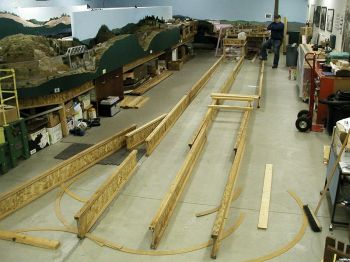
|
Dave S. stands near Keno of the
budding Klamath Falls District. The modules and other "stuff" has
been
moved aside or out to the shed. BCI's have been placed
approximately where they will go to support the layout.
The P&E main line will leave the helix just beyond where Dave is
standing. It will follow the right set of BCI's towards the
camera. Pelican Yard will be built about where boards are laid
across the BCI's and the main will continue to the bottom of the
picture. The P&E will then turn 180 degrees across Lake
Ewauna just as the BN does. Curve templates in the bottom left
rough out the Lake Ewauna crossing
and wye onto the Southern Pacific. Following the left-most BCI,
the SP will head (SP) west away from the camera, with a small yard
across the lake from Pelican Yard. There will be a crossover to
the BN just after the P&E joins the SP. The BN yard
will be built between the center and left hand BCI's near the top of
this picture.
Friday, January 9, 2009
|
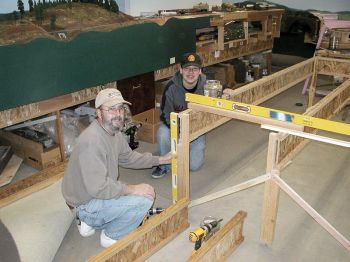
|
The BCI's and
legs went together in just one day with an assembly line
process. While other members precut legs and cross braces, Brad
and Carlos assembled them into the benchwork. Care was taken to
ensure the legs were plumb and the BCI's were level. 3/8"
carriage bolts screwed into T nuts drilled into the ends of the legs
allowed for adjustment on our slightly undulating floor.
Saturday, January 10,
2009
|
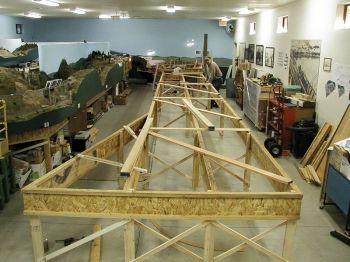
|
At the end of the first day
of construction, the benchwork framing was done. Standing down at
the end, Dave admired the work.
Saturday, January 10,
2009 |
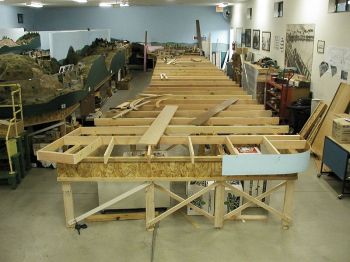 |
Progress continued at a
rapid pace with the 1 x 4 joists cut and fastened to the BCI's in
a single day.
Tuesday, January 13, 2009
|
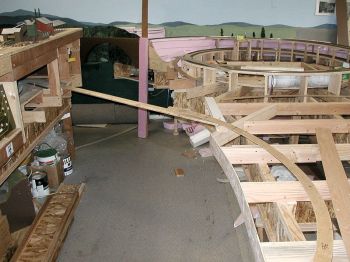
|
One of the
features the club decided on is the ability to return trains
from the Klamath Falls District back to the rest of the layout so as to
"recycle" them during Sunday open run days. The idea being to
keep trains moving for the public. A scheme was devised for the
BN's Gateway Sub to cross over the aisle and tie in with the Siskiyou
Line Staging yard. A bit of a stretch of the imagination, to be
sure, but for our prototype "op sessions" this feature would not
be used. The curve template in the photo approximates the
BN yard's throat with a length of plywood (diagonal) testing the
alignment for the bridge across the aisle. When not in
use, the bridge will swing to the right and nestle under the helix and
scenery.
|
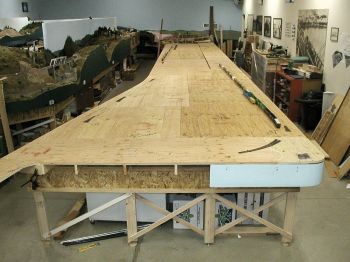
|
The first week of
construction ended as 3/4" plywood was cut and laid over the
joists. We joke that it looked more like an air craft carrier
than
a model railroad and briefly contemplated borrowing some model
planes. But, alas, we came to our senses and broke out some track
and models to get a feel for how the P&E's Pelican Yard will
fit. A 20 car train sits where the P&E main will pass
through the yard.
Friday, January 16, 2009
|
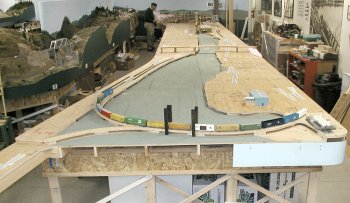
|
The rapid pace slowed some
as track layout and major scenic features received consideration.
Dave Spakousky came up with the idea of using photocopies of track
switches in order to lay out yard ladders, main line crossovers,
etc. The idea worked and every place you see a white slip of
paper in this photo a track switch will be placed. Having track
locations approximated enabled us first to paint and then to cut out
Lake Ewauna. Here we see the track and service areas raised 1
1/2" above the joists with the lake cutout, which rests directly on the
1 x
4's. In the foreground the sub-roadbed, some of it
temporary, supports a string of cars leaving the SP main on the left
and about to enter Pelican Yard on the right. The four black
sticks are where the Lake Ewauna bridge will go. The blue
structure on the P&E side is a trial engine house (it proved too
small). Part way down the lake is a mockup of Hwy. 140.
Tuesday, January 27, 2009
|
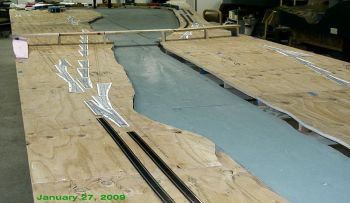
|
In
a view from the opposite end, a better look at the west end of Pelican
Yard's ladder tracks and how the photocopy switches work.
In what may seem like a travesty of layout planning conventions, all
the trackage on this leg was laid out without working drawings.
We knew what we wanted and approximately where it would go.
Diagrams in books helped since Pelican Yard is located where the BN's
White Yard is to this day. The SP yard was moved west and the BN
yard was swung parallel with the SP yard. It
helped that our yards and the
areas around them are fairly flat so we could use plywood
throughout. Working with the photocopy switches, a long
straightedge, a
tape measure and a few sticks of flex track for effect, the yards and
mains were laid out, adjusted and tweaked. Essentially we did our
planning in full scale.
Tuesday, January 27, 2009
|
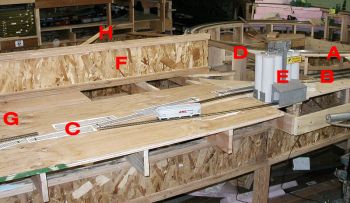
|
The
transition of scenery from the mountain and helix A
near Keno to the relatively flat Klamath yards is a challenge.
We're trying to compress about 10 miles of real life into two feet on
our railroad. The main line, Keno siding and Klamath (continuous
run) Loop emerge from under the helix at B but we don't want a tunnel
there. Hence the US 97 overpass D will hide the tracks as
they disappear with a hillside on one side of the highway and a bridge
below the other. A large grain elevator E will help draw attention away
from this trick. The siding and main converge to a single
track behind the elevator and continue, with the Loop, as a two track
main C through a pair of
mills G and on to Pelican
Yard. F is where the
painted scenic divider will be and H
is
the swing bridge on the other side where the BN's Gateway Sub
miraculously joins the Siskiyou Line...but only on summer
Sundays.
|
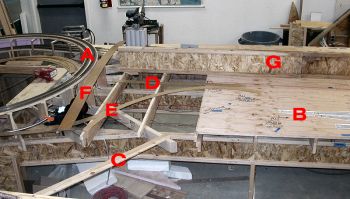
|
The BN/SP side by the helix
presented some more challenges. First of all, this is the end of
the modeled portion of the railroads on the Klamath Falls
District. We
need to make the SP and BN disappear gracefully yet still allow for
certain operations. The helix A will be de-emphasized in this
scene with a hill, cuts and trees. The BN main B crosses the swing bridge C and goes out on the Gateway
Sub (aka Siskiyou Staging). Meanwhile the SP main D goes through a small cut and
grove of trees to disappear under the helix and become a staging
track. D and E represent Texum with E becoming the Modoc Sub or, in
our world, the Klamath Loop continuous run track for Sunday public
runs. F is the Hwy.
140 (US 97 on the other side of
the divider) overpass , moved
south from it's proper location and helping to hide
the disappearance of the SP tracks. G is the divider separating
this scene from Keno on the other side.
|
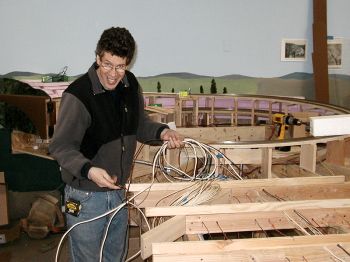
|
If there's one thing we
learned the hard way building the first two thirds of the Pacific &
Eastern it's that if you don't do the wiring right the first
time, you get to do it again...and sometimes yet again.
Fortunately Ed Kleinman has since joined the club and brought
with him a wealth of electronic expertise. At his urging, we slid
the plywood aside and broke out the drills and rolls of
wire. Wiring for DCC buses, DCC sub-buses, occupancy
detection, signals, Loconet, 120 VAC and a few spare circuits then
consumed our efforts for a couple weeks. Thinking it through
first and doing it right the first time is WELL worth the time and
effort. We've probably cut our wiring time and effort in
half by doing it this way over the previous version of laying all the
track and then getting under the benchwork to run all the wire.
Saturday, January 31,
2009
|

|
Construction of the Klamath Falls District continues.
|

